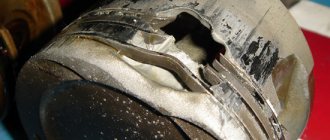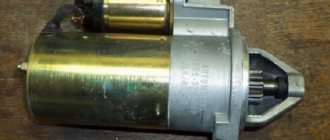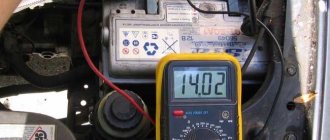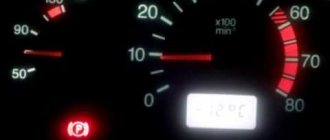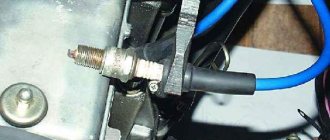Why do spark plugs turn black and how to get rid of carbon deposits?
The presence of black carbon deposits on the spark plugs should alert the car owner.
This phenomenon is not typical for a working engine, which means that some of its systems have malfunctioned. As a rule, these are: ignition systems (carburetor), power supply (injector), fuel, lubrication, and malfunctions in the gas distribution and crank mechanisms may also occur.
Despite the fact that blackening of spark plugs can be caused by many reasons, diagnosing them is not as difficult as it seems at first glance. This is what we will talk about in this article.
Black plaque - what is it?
It is black carbon deposits that most often form on spark plugs. There are 2 types of black soot - the structure of the plaque also varies. If the coating has a grayish tint, there is no need to worry - this is a sign of stable engine operation.
If the electrode or threaded connections are covered with oily soot, this means that when the engine is running, too much working fluid ends up in the combustion chamber. This phenomenon has an accompanying symptom: when the engine starts, blue smoke begins to come out of the exhaust. There are several possible reasons:
- piston caps are worn out;
- the piston rings have become unusable;
- valve bushings have expired.
The appearance of black carbon deposits on spark plugs is associated with wear and tear on the components of the cylinder-piston system. The problem is solved by replacing worn parts with new ones.
Another type of resin deposit is called “velvety.” In this case there are no traces of oil. The appearance of soot deposits of this type is associated with the appearance in the combustion chamber of a TV mixture, the fuel content of which greatly exceeds the norm. Then a dry resin deposit forms. This occurs due to a malfunction of the candle - if it has ceased to produce the amount of energy necessary for ignition. Soot settles on the electrodes and never appears on the threads.
Causes of black soot
Before finding out the reason why the candles turned black, it is important to understand how this happened, how many of them turned black (one, two or all at once), on which side the soot formed (on one, two or all around), how “dry” it is. or "wet".
This determines how to diagnose and what to pay attention to first.
It is also important to understand that some malfunctions contribute to the rapid formation of black soot and affect its character, and some chronic engine problems can change the condition of the spark plugs gradually.
But before you indulge in various breakdowns, make sure:
- Is the idle speed set correctly, especially for carburetor engines?
- Are you driving the car correctly, are you not overloading the engine with high speeds, what is the cruising speed on a flat road. Those. It is important to make sure that the machine was operated as correctly as possible and the spark plugs worked in their optimal mode.
- If the conditions listed in paragraph 2 are met, the appearance of the first slight deposit on new spark plugs will occur after 150 - 200 km. If earlier, and it is clearly black, then you should sound the alarm.
- Late ignition - uniform black carbon deposits form on the spark plug.
- Malfunctions in the ignition system (carburetor engine). The following malfunctions can lead to incomplete combustion of fuel in the cylinders as a result of a weak spark or to failures in its formation and, as a result, the appearance of black soot, these are: faulty ignition coil and spark plugs themselves, poor insulation of high-voltage wires, ignition angle is set incorrectly, breakdown of the distributor runner and the cover itself.
If the engine is running on a rich fuel mixture or late ignition is observed, this will manifest itself:
- High level of engine vibration as a result of its unstable operation, especially at low speeds.
- The appearance of error P0300 on the instrument panel of an injection car and misfires on the carburetor.
- Poor engine starting.
The most dangerous thing for spark plugs is oil getting on them and simultaneously overheating. This will lead not only to their rapid blackening, but also to failure of the electrodes - they cannot be repaired.
Sequence of actions when adjusting
- Check the cable tension, there may be two options - excessive tension or insufficient;
- Using a 13 key, adjust the cable tension;
- Check: when the gas pedal is depressed, the throttle should be fully open, and when the pedal is released, it should be closed;
- Using a 13mm wrench, adjust the position of the locknut so that the result is optimal.
Next comes the turn of the air damper:
- You need to remove the cover from the air filter;
- Replace the filter if necessary;
- Check: if the choke handle is recessed completely, then the damper should be under the dashboard and be completely open;
- Turn the damper lever until it is fully open;
- Press the lever all the way down;
- Remove the cable from the insulation and press the traction adjustment bolt;
- Check the damper again;
- If necessary, gradually advance the cable sheath, tighten the fastening bolt;
- If the desired result is achieved, tighten the bolt to the lever and close the filter cover.
The next step is the starting device. It can be adjusted without removing the carburetor and with removal. If it is not possible to remove the carburetor, you need a tachometer. Remove the air filter housing and remove the choke lever completely. The lever is located under the dashboard in the cabin. Start the engine and watch what happens.
Open the air vent a third of the way using a flathead screwdriver. Using a 7 key, unscrew the adjustment bolt until you reach a reading of 3100-3400 rpm on the tachometer. After achieving the result, lower the damper.
Next, adjust the carburetor idle speed:
- Charge the battery;
- Warm up the engine to operating temperature;
- Turn on the headlights, audio system and other elements that consume electrical energy;
- Achieve maximum idle speed;
- Rotating the quality screw, reduce the speed by 50-150.
Remember that if the carburetor is regularly cleaned and adjusted, it will work for a long time, repairs and replacements will not be required, and it will also reduce fuel consumption.
What to do if black soot appears
First you need to understand the severity of the problem and where it comes from. To do this, unscrew all the spark plugs and inspect them. If only one is blackened and the others are clean, then install it in another cylinder, i.e. swap places. After a couple of tens of kilometers, repeat the inspection.
If nothing has changed, then simply replace the blackened spark plug with a new one, this is most likely the problem. And if a spark plug with carbon deposits in another cylinder is cleaned, but a clean one, on the contrary, turns black, then the problem must be looked for in the cylinder.
Carburetor VAZ 2107, 2106, 2109, 2110
I would like to dwell in more detail on carburetor cars VAZ 2107, 2106, 2109, 2110, what you should pay attention to first if black spark plugs are found in them.
First of all, pay attention to the “behavior” of the engine, whether it revs or not. If the spark plug is black and dry, then the fault lies in the fuel system, and if it is wet, then in the oil that has penetrated into the combustion chamber. The problem may also be in the ignition, which is set incorrectly.
Pay attention to the carburetor, check:
- The second chamber - it must be dry;
- Is the mixture quality screw adjusted correctly?
You also need to check the condition of the spark plug itself, the high-pressure wire (may break through to ground), and the distributor. Don’t forget about the ignition coil; how to check it, read here https://autotopik.ru/sovet/997-kak-proverit-katushku-zazhiganiya-multimetrom.html.
If the engine does not start to stall immediately, but after warming up, then again go through the above points, plus, check the valve adjustment.
Varieties of black soot
The black color indicates the presence of ordinary soot on the candle, that is, unburned amorphous carbon. It is produced by petroleum products and other organic matter that have failed to oxidize properly.
A more accurate assessment of the situation is determined by both the shades of color and the nature of its distribution over the working part of the candle. The appearance of any belts around the outer part of the insulator, located above the hexagon under the spark plug wrench, is usually not a cause for concern, although many auto repairmen mercilessly reject good spark plugs for this very reason. At the very least, this is not justified.
- Uniformity of carbon deposits. It can be concentrated only on the metal of the electrodes, lie on the insulator on one side, or have a location in the form of a cone going deep into the body. As if revealing the source of its appearance in the form of uneven carbon flow or temperature changes along the insulator.
- External dryness of soot. It may look slightly damp and even have a different smell, for example, a strong smell of gasoline. There should be no gasoline remaining in a properly functioning cylinder.
- Oiliness. The porous carbon structure is easily impregnated with oil, and is often formed from it. There are always oil vapors in the combustion chamber, but normally their amount is negligible, and they burn out instantly.
- “Velvet” type of soot. This indicates its large-pore structure, that is, rapid formation and increase in volume.
- The opposite situation is a dense, even possibly shiny deposit. It accumulates for a long time, is durable and does not have a radical black tint.
- Combination of black with other colors. For example, red or brown.
This is interesting: Main bearings.
Such nuances indicate various causes of problems. If you rely on them when diagnosing, you need to make sure that the formations are stable and did not accidentally appear a minute ago. To do this, the engine must at least be warmed up, or better yet, loaded with tens of kilometers of movement at a fairly high speed.
The nature of the deposit will tell you about the causes of malfunctions
The shade of soot on the electrodes of the elements is a clear signal of what kind of failures in the power unit could lead to this. This is often due to the fact that sparking does not occur correctly, the composition of the fuel used or the temperature indicator inside the combustion chamber does not meet the requirements. We will tell you why the candles turn black later.
How to clean spark plugs from plaque
It is important to understand that clean spark plugs work 15% more efficiently than dirty ones, so it is recommended to check their condition and, if necessary, clean them every 10 thousand km. mileage, just when changing the engine oil. But it all depends on the type of products used. As a rule, many car owners immediately change regular spark plugs at such a mileage, without bothering with cleaning, although it is recommended to do this at 40-50 thousand.
But platinum and iridium spark plugs last longer and are replaced after 80-90 thousand mileage.
The timing of checking the condition of the candles should be reduced if the symptoms that we discussed above appear.
It is also important to understand that the old-fashioned methods of cleaning with sandpaper should be forgotten, especially for iridium spark plugs where there is a deposit on the thin electrode, the removal of which is strictly contraindicated.
Why does black carbon appear on spark plugs?
The appearance of black soot (plaque) on the electrodes of the spark plugs indicates problems with mixture formation in the engine cylinders and (or) malfunction of the ignition system elements - problems with sparking.
Signs of malfunction: black carbon deposits on the spark plug electrodes
Unstable engine idling (engine “troits”).
Difficulties in engine operation after pressing the gas pedal (both at idle and while the car is moving).
Popping sounds in the muffler (misfire is heard).
Problems starting the engine.
Causes of the malfunction: why does black carbon deposits appear on the spark plugs?
Spark plugs are faulty
("insulator is broken", the glow number of the spark plugs does not correspond to the engine, the gap between the electrodes of the spark plug is small, the internal defect of the spark plug).
High-voltage wires are broken
(the spark goes to ground).
As a result of the listed malfunctions of the ignition system, the spark on the spark plug electrodes is weak or absent altogether, the fuel mixture does not burn completely and settles in the form of carbon deposits on the spark plugs.
The ignition module (coil) is faulty.
Perhaps it “breaks through” to ground, reducing the spark discharge.
Ignition timing too early or too late
(for carburetor engines). The normal combustion of the fuel mixture in the combustion chambers of the engine is disrupted.
The engine constantly runs on too rich a fuel mixture.
The fuel injection system (for injection engines) may be faulty - the injectors are clogged or leaking, high or, conversely, low pressure in the fuel rail is due to a malfunction of the electric fuel pump or fuel pressure regulator.
Malfunctions in the operation of elements of the engine control system (ECM). The ECM control unit calculates the amount of fuel injected based on the readings of sensors installed on the engine. First of all, these are the mass air flow sensor (MAF), the oxygen sensor (OK) and the coolant temperature sensor (DTOZH). In some cases, incorrect data coming from them causes the control unit to increase the fuel supply through the injectors.
The carburetor and/or fuel pump (for carburetor engines) is faulty. Malfunctions: the air jets of the gas pump are clogged, the level in the float chamber is too high, the needle valve of the float chamber is not sealed, the fuel and (or) air jets do not correspond to the rating, the fuel pump creates excess pressure (its drive is not adjusted or the valves are stuck). In any case, the carburetor will prepare a rich fuel mixture and the spark plug electrodes will turn black.
The engine itself is faulty.
The valves are not adjusted, the valve timing is off, the piston group (rings, pistons, cylinders) is worn out.
Idle speed adjustment
The second setting of the VAZ-2109 carburetor is idle speed, it can be partial or full. The first is for minor speed adjustments, the second is for adjusting the amount of air (setting CO emissions in the exhaust gases).
Partial adjustment is performed using the air-fuel mixture “amount” screw. This screw sets the opening angle of the throttle valves, which ensures that the air-fuel mixture enters the cylinders when the accelerator pedal is released. The “quantity” screw rests on the throttle valve control lever and when screwed in, it pushes the lever, causing the valves to open slightly.
Partial idle adjustment is performed with a warm engine and creating a load on the vehicle's on-board network by turning on the high beam headlights and the interior heater at full power. The adjustment is carried out with the engine running by screwing in/unscrewing the “quantity” screw until the optimal idle speed is established, which for the VAZ-2109 is 800-900 rpm (this can be tracked using a standard or plug-in tachometer).


